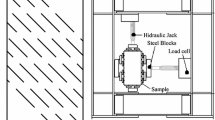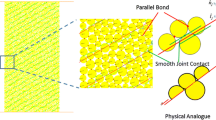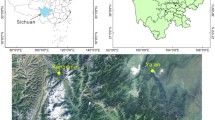Summary
To use the distinct element method, it is necessary to discretize the problem domain into polygons in two dimensions (2 D) or into polyhedra in three dimensions (3 D). To perform distinct element stress analysis in a rock mass which contains non-persistent finite size joints, it is necessary to generate some type of fictitious joints so that when they are combined with the non-persistent joints, they discretize the problem domain into polygons in 2 D or into polyhedra in 3 D. The question arises as to which deformation and strength parameter values should be assigned to these fictitious joints so that they behave as intact rock. In this paper, linear elastic, perfectly-plastic constitutive models with the Mohr-Coulomb failure criterion, including a tension cut-off, were used to represent the mechanical behaviour of both intact rock and fictitious joints. It was found that, by choosing the parameter values for the constitutive models as given below, it is possible to make the fictitious joints behave as intact rock, in a global sense.
-
a)
For both the intact rock and the fictitious joints, the same strength parameter values should be used.
-
b)
A joint shear stiffness (JKS) value for fictitious joints should be chosen to produce a shear modulus/JKS ratio (G/JKS) between 0.008 and 0.012 m.
-
c)
A joint normal stiffness/JKS ratio (JKN/JKS) between 2 and 3 should be chosen. The most appropriate value to choose in this range may be the Young's modulus/G value (E/G) for the particular rock.
Some examples are given in the paper to illustrate how to use the distinct element method to perform stress analysis of rock blocks which contain non-persistent joints and to study the effect of joint geometry parameters on strength and deformability of rock masses.
Similar content being viewed by others
References
Baecher, G. B., Lanney, N. A., Einstein, H. H. (1977): Statistical description of rock properties and sampling. In: Proc., 18th U. S. Symp. on Rock Mech., 5C1-8.
Bieniawski, Z. T. (1968): The effect of specimen size on compressive strength of coal. Int. J. Rock Mech. Min. Sci. 5, 321–335.
Bieniawski, Z. T. (1978): Determining rock mass deformability: experience from case histories. Int. J. Rock Mech. Min. Sci. 15, 237–247.
Bieniawski, Z. T., Van Heerden, W. L. (1975): The significance of in-situ tests on large rock specimens. Int. J. Rock Mech. Min. Sci. 12, 101–113.
Brown, E. T. (1970a): Strength of models of rock with intermittent joints. J. Soil Mech. Found. Div., ASCE 96, 1935–1949.
Brown, E. T. (1970b): Modes of failure in jointed rock masses. In: Proc., 2nd Congress Intern. Soc. of Rock Mechanics, Belgrade, Vol. 2, 3–42.
Chappel, B. A. (1974): Load distribution and deformational response in discontinua. Geotechnique 24, 641–654.
Cundall, P. A. (1971): A computer model for simulating progressive large scale movements in blocky rock system. In: Proc., Intern. Soc. of Rock Mechanics, Nancy, Vol. 1.
Cundall, P. A. (1988): Formulation of a three-dimensional distinct element model — Part 1. A scheme to detect and represent contacts in a system composed of many polyhedral blocks. Int. J. Rock Mech. Min. Sci. 25, 107–116.
Dershowitz, W. S., Einstein, H. H. (1988) Characterizing rock joint geometry with joint system models. Rock Mech. Rock Engng. 21, 21–51.
Einstein, H. H., Hirschfeld, R. C. (1973): Model studies on mechanics of jointed rock. J. Soil Mech. Found. Div., ASCE 99, 229–242.
Goodman, R. E. (1989): Introduction to rock mechanics. John Wiley, New York.
Goodman, R. E., Taylor, R. L., Brekke, T. L. (1968): A model for the mechanics of jointed rock. J. Soil Mech. Found. Div., ASCE 94, 637–659.
Hardin, E. L., Barton, N. R., Lingle, R., Board, M. P., Voegele, M. D. (1982): A heated flatjack test to measure the thermomechanical and transport properties of rock masses. Office of Nuclear Waste Isolation, Columbus, Ohio.
Hart, R., Cundall, P. A., Lemos, J. (1988): Formulation of a three-dimensional distinct element model — Part II: Mechanical calculations for motion and interaction of a system composed of many polyhedral blocks. Int. J. Rock Mech. Min. Sci. 25, 117–126.
Heuze, F. E. (1980): Scale effects in the determination of rock mass strength and deformability. Rock Mech. 12, 167–192.
Hoek, E., Brown, E. T. (1980): Empirical strength criterion for rock masses. J. Geotech. Engng. Div., ASCE, 1013–1035.
John, K. W. (1970): Civil engineering approach to evaluate strength and deformability of closely jointed rock. Rock Mechanics — Theory and Practice. In: Proc., 11th Symp. on Rock Mechanics, AIME, New York, 69–80.
Kulatilake, P. H. S. W. (1985): Estimating elastic constants and strength of discontinuous rock. J. Geotech. Engng., ASCE 111, 847–864.
Kulatilake, P. H. S. W. (1988): Stochastic joint geometry modelling: State-of-the-art. In: Proc., 29th U. S. Symp. Rock Mechanics, Minneapolis, 215–229.
Ladanyi, B., Archambault, G. (1970): Simulation of shear behavior of a jointed rock mass. In: Proc., 11th Symp. on Rock Mechanics, AIME, New York, 105–125.
Lemos, J. V., Hart, R. D., Cundall, P. A. (1985): A generalized distinct element program for modelling jointed rock mass. In: Proc., Symp. on Fundamentals of Rock Joints, Bjorkliden, 335–343.
Lorig, L. J., Brady, B. H. G., Cundall, P. A. (1986): Hybrid distinct element — boundary element analysis of jointed rock. J. Rock Mech. Min. Sci. Geomech. Abstr. 23, 303–312.
Pratt, H. R., Black, A. D., Brown, W. S., Brace, W. F. (1972): The effect of specimen size on the mechanical properties of unjointed diorite. Int. J. Rock Mech. Min. Sci. 9, 513–529.
Author information
Authors and Affiliations
Rights and permissions
About this article
Cite this article
Kulatilake, P.H.S.W., Ucpirti, H., Wang, S. et al. Use of the distinct element method to perform stress analysis in rock with non-persistent joints and to study the effect of joint geometry parameters on the strength and deformability of rock masses. Rock Mech Rock Engng 25, 253–274 (1992). https://doi.org/10.1007/BF01041807
Issue Date:
DOI: https://doi.org/10.1007/BF01041807




